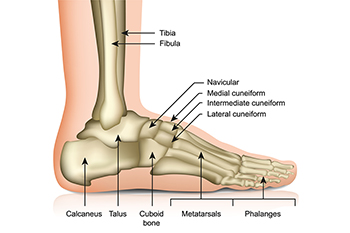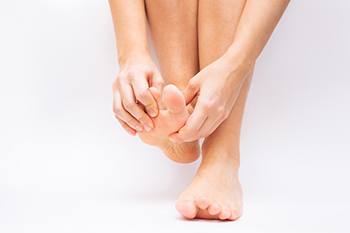Items filtered by date: August 2024
Foot Pain Is Common

Foot problems are common but can often be prevented with simple measures like wearing well-fitting shoes. Shoes that are too tight or loose can lead to blisters, calluses, and other painful issues. Foot pain can stem from various causes, including bunions, plantar fasciitis, and arthritis. It is important to address these problems early to avoid further complications. For those with diabetic patients, foot care is particularly imperative, as they are at a higher risk of developing serious conditions like ulcers and infections due to poor circulation and nerve damage. If you have foot pain, it is suggested that you consult with a podiatrist, especially if you experience persistent pain or have underlying health conditions. Wearing proper footwear, daily foot inspections, and professional guidance can help maintain foot health and prevent complications.
Foot Pain
Foot pain can be extremely painful and debilitating. If you have a foot pain, consult with one of our podiatrist from North Texas Podiatry Associates. Our doctors will assess your condition and provide you with quality foot and ankle treatment.
Causes
Foot pain is a very broad condition that could be caused by one or more ailments. The most common include:
- Bunions
- Hammertoes
- Plantar Fasciitis
- Bone Spurs
- Corns
- Tarsal Tunnel Syndrome
- Ingrown Toenails
- Arthritis (such as Gout, Rheumatoid, and Osteoarthritis)
- Flat Feet
- Injury (from stress fractures, broken toe, foot, ankle, Achilles tendon ruptures, and sprains)
- And more
Diagnosis
To figure out the cause of foot pain, podiatrists utilize several different methods. This can range from simple visual inspections and sensation tests to X-rays and MRI scans. Prior medical history, family medical history, and any recent physical traumatic events will all be taken into consideration for a proper diagnosis.
Treatment
Treatment depends upon the cause of the foot pain. Whether it is resting, staying off the foot, or having surgery; podiatrists have a number of treatment options available for foot pain.
If you have any questions, please feel free to contact our offices located in Euless and Southlake, TX . We offer the newest diagnostic and treatment technologies for all your foot care needs.
It's Time for Beautiful Feet
The Architecture of the Foot

The foot is a marvel of anatomical design, essential for effective heel-to-toe walking. The heel's support comes from the calcaneus bone, which absorbs impact during the initial heel strike. The Achilles tendon, connecting the calf muscles to the heel, plays a vital role in lifting the heel and propelling the body forward. The fibula and tibia, the major bones of the lower leg, provide structural stability and support to the ankle joint. The talus, situated between the tibia and calcaneus, facilitates smooth movement of the foot. As the foot rolls forward, the metatarsals and phalanges work together to push off the ground. This intricate coordination of bones, tendons, muscles, and ligaments ensures efficient movement and balance throughout each step. A podiatrist is medically qualified to treat foot and ankle conditions. If you have injured your foot or have chronic foot pain, it is suggested that you contact a podiatrist who can offer safe and effective treatment solutions.
If you have any concerns about your feet, contact one of our podiatrist from North Texas Podiatry Associates. Our doctors can provide the care you need to keep you pain-free and on your feet.
Biomechanics in Podiatry
Podiatric biomechanics is a particular sector of specialty podiatry with licensed practitioners who are trained to diagnose and treat conditions affecting the foot, ankle and lower leg. Biomechanics deals with the forces that act against the body, causing an interference with the biological structures. It focuses on the movement of the ankle, the foot and the forces that interact with them.
A History of Biomechanics
- Biomechanics dates back to the BC era in Egypt where evidence of professional foot care has been recorded.
- In 1974, biomechanics gained a higher profile from the studies of Merton Root, who claimed that by changing or controlling the forces between the ankle and the foot, corrections or conditions could be implemented to gain strength and coordination in the area.
Modern technological improvements are based on past theories and therapeutic processes that provide a better understanding of podiatric concepts for biomechanics. Computers can provide accurate information about the forces and patterns of the feet and lower legs.
Understanding biomechanics of the feet can help improve and eliminate pain, stopping further stress to the foot.
If you have any questions please feel free to contact our offices located in Euless and Southlake, TX . We offer the newest diagnostic and treatment technologies for all your foot and ankle needs.
Causes of Numbness in the Toes

Experiencing numbness in your toes can be disconcerting, as it often points to underlying health issues. One of the most common causes of numb toes is wearing tight shoes that restrict circulation and compress nerves. Diabetes is another major factor, with high blood sugar levels leading to peripheral neuropathy that decreases sensation in the feet. The buildup of plaque in arteries can result in peripheral artery disease, which causes numbness in the toes from restricted blood flow. Hypothyroidism, where the thyroid gland produces insufficient hormones, may lead to fluid retention and nerve damage, affecting the toes. Other causes of numb toes can include bunions, Morton's neuroma, and vitamin B12 deficiency, each affecting the nerves and blood supply to the toes. A podiatrist can help identify the specific cause of numbness through a series of tests. If your toes are frequently numb, it is suggested that you schedule an appointment with a podiatrist for an exam, diagnosis, and treatment.
Neuropathy
Neuropathy can be a potentially serious condition, especially if it is left undiagnosed. If you have any concerns that you may be experiencing nerve loss in your feet, consult with one of our podiatrist from North Texas Podiatry Associates. Our doctors will assess your condition and provide you with quality foot and ankle treatment for neuropathy.
What Is Neuropathy?
Neuropathy is a condition that leads to damage to the nerves in the body. Peripheral neuropathy, or neuropathy that affects your peripheral nervous system, usually occurs in the feet. Neuropathy can be triggered by a number of different causes. Such causes include diabetes, infections, cancers, disorders, and toxic substances.
Symptoms of Neuropathy Include:
- Numbness
- Sensation loss
- Prickling and tingling sensations
- Throbbing, freezing, burning pains
- Muscle weakness
Those with diabetes are at serious risk due to being unable to feel an ulcer on their feet. Diabetics usually also suffer from poor blood circulation. This can lead to the wound not healing, infections occurring, and the limb may have to be amputated.
Treatment
To treat neuropathy in the foot, podiatrists will first diagnose the cause of the neuropathy. Figuring out the underlying cause of the neuropathy will allow the podiatrist to prescribe the best treatment, whether it be caused by diabetes, toxic substance exposure, infection, etc. If the nerve has not died, then it’s possible that sensation may be able to return to the foot.
Pain medication may be issued for pain. Electrical nerve stimulation can be used to stimulate nerves. If the neuropathy is caused from pressure on the nerves, then surgery may be necessary.
If you have any questions, please feel free to contact our offices located in Euless and Southlake, TX . We offer the newest diagnostic and treatment technologies for all your foot care needs.
Bunion Deformities
 A bunion, medically known as hallux valgus, is a deformity characterized by the misalignment of the big toe joint, causing the toe to lean toward the other toes and creating a noticeable bump on the side of the foot. This condition often results from a genetic predisposition, wearing tight or ill-fitting shoes, high heels, or conditions such as arthritis. Symptoms of a bunion can include pain, swelling, redness surrounding the affected joint, and difficulty walking. Over time, the deformity can worsen, leading to increased discomfort and mobility issues. Conservative treatments for bunions include wearing wide-toed shoes, using protective pads to reduce friction, wearing orthotics, and taking mild pain relievers. If conservative methods fail to provide relief, more invasive options can include corticosteroid injections to reduce inflammation or bunionectomy surgery to realign the bones, tendons, and ligaments. If you have a painful bunion, it is suggested that you schedule an appointment with a podiatrist for an accurate diagnosis and a personalized treatment plan.
A bunion, medically known as hallux valgus, is a deformity characterized by the misalignment of the big toe joint, causing the toe to lean toward the other toes and creating a noticeable bump on the side of the foot. This condition often results from a genetic predisposition, wearing tight or ill-fitting shoes, high heels, or conditions such as arthritis. Symptoms of a bunion can include pain, swelling, redness surrounding the affected joint, and difficulty walking. Over time, the deformity can worsen, leading to increased discomfort and mobility issues. Conservative treatments for bunions include wearing wide-toed shoes, using protective pads to reduce friction, wearing orthotics, and taking mild pain relievers. If conservative methods fail to provide relief, more invasive options can include corticosteroid injections to reduce inflammation or bunionectomy surgery to realign the bones, tendons, and ligaments. If you have a painful bunion, it is suggested that you schedule an appointment with a podiatrist for an accurate diagnosis and a personalized treatment plan.
If you are suffering from bunion pain, contact one of our podiatrist of North Texas Podiatry Associates. Our doctors can provide the care you need to keep you pain-free and on your feet.
What Is a Bunion?
Bunions are painful bony bumps that usually develop on the inside of the foot at the joint of the big toe. As the deformity increases over time, it may become painful to walk and wear shoes. Women are more likely to exacerbate existing bunions since they often wear tight, narrow shoes that shift their toes together. Bunion pain can be relieved by wearing wider shoes with enough room for the toes.
Causes
- Genetics – some people inherit feet that are more prone to bunion development
- Inflammatory Conditions - rheumatoid arthritis and polio may cause bunion development
Symptoms
- Redness and inflammation
- Pain and tenderness
- Callus or corns on the bump
- Restricted motion in the big toe
In order to diagnose your bunion, your podiatrist may ask about your medical history, symptoms, and general health. Your doctor might also order an x-ray to take a closer look at your feet. Nonsurgical treatment options include orthotics, padding, icing, changes in footwear, and medication. If nonsurgical treatments don’t alleviate your bunion pain, surgery may be necessary.
If you have any questions, please feel free to contact our offices located in Euless and Southlake, TX . We offer the newest diagnostic and treatment technologies for all your foot care needs.

